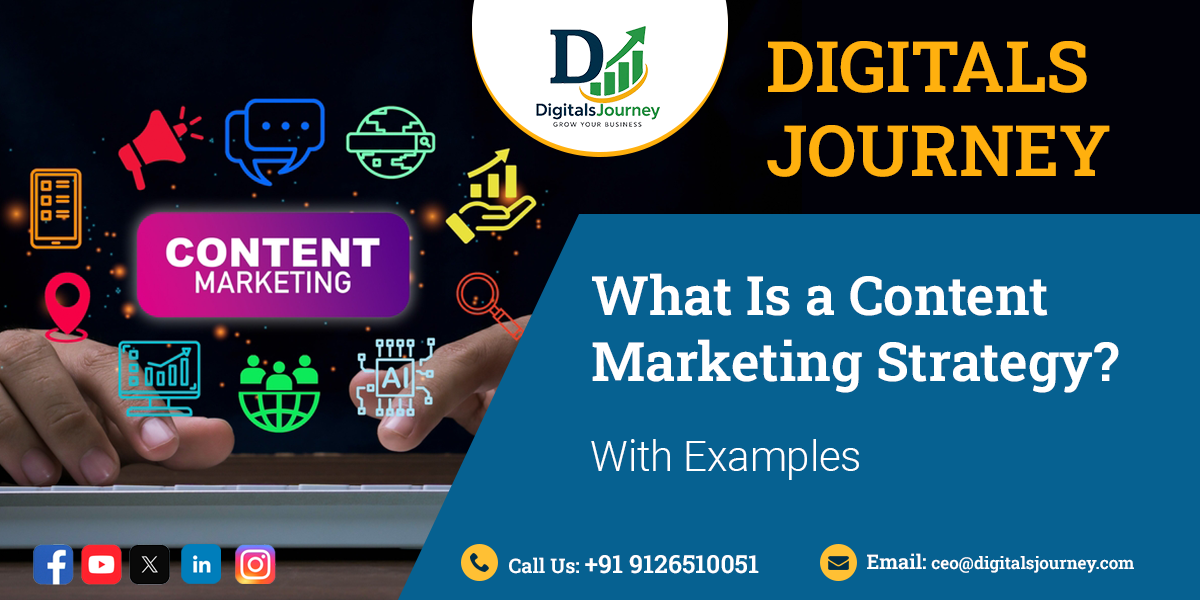
What Is a Content Marketing Strategy? With Examples
What Is a Content Marketing Strategy?
A content marketing strategy essentially outlines how a business will utilize content to reach, engage, and convert its audience. A content marketing strategy will include aspects like who you are speaking to, what you are creating, how you are getting your content out there, and how you are tracking success. In its simplest terms, content marketing isn’t just about content; it’s purpose-driven content that satisfies business goals like traffic, leads, and/or brand awareness.
Why Your Business Should Have a Content Strategy:
Without a strategy (no matter how much effort you put into your content), you crumble. A good content marketing strategy will help you:
• Build trust with your audience
• Improve search engine rankings
• Increase leads and sales
• Develop a thought leadership position
• Create an overall consistent brand message
A good content strategy is the foundation of your digital marketing success in 2025, especially with AI content and competition for consumer attention.
Key Components of a Content Marketing Strategy
|
Component |
Description |
|
Audience Research |
Who are you creating content for? |
|
Content Goals |
What do you want to achieve? (Traffic, leads, etc.) |
|
Content Types |
Blog posts, videos, infographics, etc. |
|
Content Calendar |
When and how often will you post? |
|
Distribution Channels |
Where will you publish and promote? |
|
Metrics |
How will you measure success? |
Step-by-Step Guide to Creating a Content Strategy
This process helps align content efforts with real business results.
Content Formats to Include in Your Strategy
Use a mix of formats based on your audience preferences and platform strengths.
Content Distribution Channels
|
Channel Type |
Examples |
|
Owned Media |
Website, blog, newsletter |
|
Earned Media |
Press mentions, shares, backlinks |
|
Paid Media |
Facebook Ads, Google Ads, sponsored posts |
Pro Tip: Use owned media for control, earned for credibility, and paid to amplify high-performing content.
The Role of SEO in Content Strategy
SEO is the foundation of content visibility. You can include SEO in your content strategy by:
• Doing keyword research, with tools such as Ubersuggest or Semrush
• Creating content clusters around main topics for your business
• Optimizing for on-page SEO. Remember meta tag descriptions, headers, and alt text
• Keeping your content updated so you maintain your ranking
This way when people are looking for answers your content reaches them.
How to Measure Success; What Metrics Should You Track?
• Website Traffic - total unique visits, and unique visits by source
• Engagement - time on page, scroll-depth, social shares
• Leads & Conversions - sign-ups, form submissions, sales
• Bounce Rate - are they lingering?
• Content ROI - revenue or leads generated for each piece of content
You should be able to use Google Analytics, HubSpot, or ContentKing to track it and improve.
Real-World Examples of Content Marketing Strategies
B2B Example – HubSpot:
Uses blog posts, free templates, and webinars to educate and nurture leads. Their strategy emphasizes value and builds trust at every stage.
B2C Example – Glossier:
Relies on user-generated content, social proof, and storytelling through blog articles and social media to drive sales and loyalty.
Small Business Example – Local Bakery:
Shares weekly recipe blogs, Instagram Reels of baking tips, and runs a monthly email to increase foot traffic and catering orders.
Content Calendar & Planning Tools
Use tools to stay organized:
Plan at least one month ahead, but remain flexible for trends or timely topics.
AI and Automation in Content Strategy (2025)
AI is now essential for scaling content efforts efficiently:
Use AI to enhance—not replace—human creativity and strategy.
Challenges in Content Marketing Strategy
Plan for these and update your strategy quarterly.
Tips for a High-Impact Strategy in 2025
? Focus on storytelling over selling
? Create value-rich, evergreen content
? Use data to personalize and segment your content
? Repurpose long-form content into micro-posts
? Combine organic + paid strategies for reach and conversions
Remember: consistency > perfection.
FAQs About Content Marketing Strategy
Q1: How long does it take to see results from content marketing?
Most see results in 3–6 months, depending on consistency and SEO strength.
Q2: Do I need to be on every platform?
No. Focus on 2–3 where your audience is most active.
Q3: How often should I post content?
Quality matters more than quantity. 1–3 times per week is a good start.
Q4: Can AI create my content strategy for me?
AI can assist, but strategy still requires human insight and creativity.
Q5: What’s the most effective content type in 2025?
Short-form video and expert-led blog content are performing best.
Q6: Should I hire a content strategist or DIY it?
Start DIY if on a budget; consider a strategist for scaling efforts.
Conclusion: Creating a Successful Content Strategy
A content marketing strategy is your guide to digital growth. It gives every blog, post, or video a distinct purpose—build trust, attract leads, and create value.
Whether you are a solo entrepreneur or part of a growing agency, defining a strategy starts you on the path to creating less, but having a more meaningful impact.
Start small, measure everything, and just remember to always put your audience first.

At Digitals Journey, we don’t just run campaigns — we craft tailored strategies, create powerful content, and build digital experiences that drive real, measurable growth for your brand.
© 2025 Digitals Journey. All Rights Reserved. Developed by DSE Consultancy Services